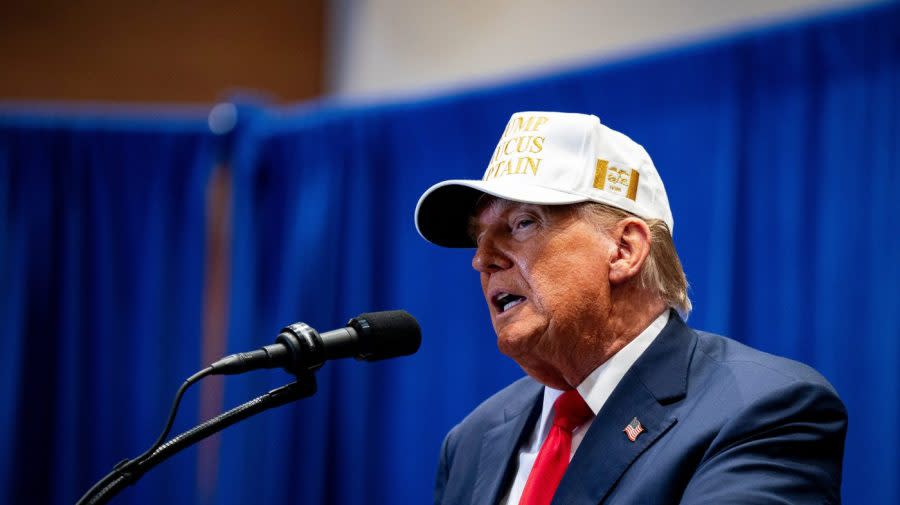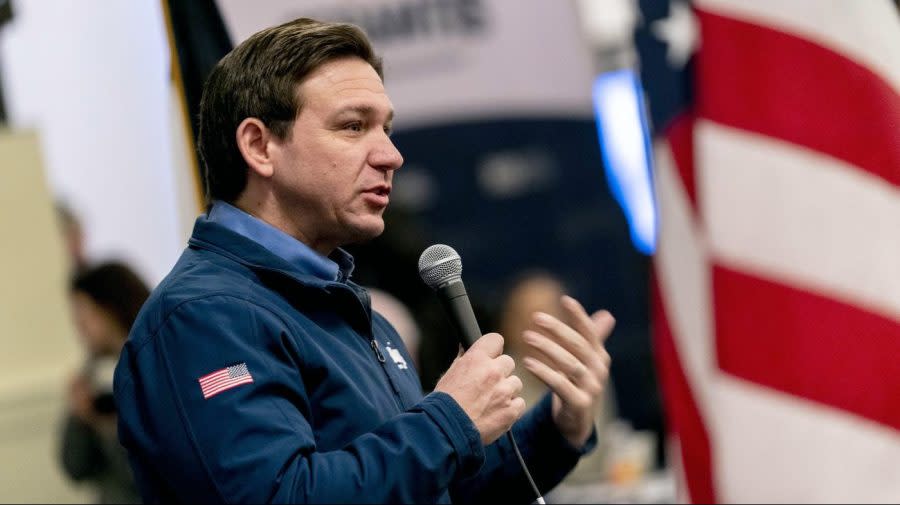5 numbers that explain the Iowa caucus results
- Oops!Something went wrong.Please try again later.
- Oops!Something went wrong.Please try again later.
- Oops!Something went wrong.Please try again later.
Former President Trump easily won the Iowa caucuses Monday, besting Republican rivals Nikki Haley and Florida Gov. Ron DeSantis in the kickoff state as the race turns quickly to New Hampshire’s primary next week.
Outlets called the race for Trump less than an hour after voting at the caucuses began in the Hawkeye State. While votes are still being tallied, Trump appears poised to win the contest by 30 percentage points, as of the most recent count.
But Trump’s margin of victory is just one of the noteworthy numbers from the first votes of the 2024 election.
Here’s Iowa’s GOP caucus day, by the numbers:
1. Trump’s percentage: 51 percent
Trump boasted 51 percent of the vote as of 12:25 a.m. ET, with roughly 109,000 votes counted by Decision Desk HQ.
The former president was leading his closest challenger by almost 30 points, with DeSantis projected to take second place and Haley set to come in third, according to Decision Desk HQ.
Trump went into the Iowa caucuses with a double-digit advantage over his rivals in the polls, and his Hawkeye State win adds to his momentum ahead of New Hampshire’s first-in-the-nation GOP primary next week.

Former President Trump speaks during a campaign event at Simpson College in Iowa on Jan. 14, 2024. Photographer: Al Drago/Bloomberg via Getty Images
It’s not a good omen for the race’s non-Trump contenders, who have been working for months to cut into Trump’s lead.
Trump won the general election in Iowa in both 2016 and 2020, but notably lost the 2016 Iowa caucuses to Sen. Ted Cruz (R-Texas) before winning New Hampshire and then the nomination.
The former president predicted earlier Monday that his campaign would see a “tremendous night” in Iowa.
2. Time the race was called: 30 minutes
The first calls from media outlets declaring Trump the winner of the caucuses came just about a half hour after caucusing began in Iowa. The Associated Press projected Trump as the winner at 8:31 p.m. ET, and other outlets soon followed.
Decision Desk HQ, a partner of The Hill, made the race call about 15 minutes later, at 8:46 p.m.
The calls came relatively soon after voting began, and while some had not yet voted. CNN anchor Jake Tapper noted the speed at which calls were made, saying after announcing CNN’s projection, “This is the earliest I can ever remember calling such a thing.”
Trump had a major lead in the polls leading up to the caucuses, and entrance polls and early results before the race was called appeared to indicate he would easily win. Tapper said CNN could make its projection based on Trump’s “overwhelming” lead in entrance polls and initial votes.
But the early calls yielded criticism for making projections while many ballots had not yet been cast. The caucus meetings vary in how long they take, with some producing results in a half hour and others taking multiple hours.
The DeSantis campaign was particularly vociferous in its reaction, with campaign spokesperson Andrew Romeo alleging “election interference.”
“Absolutely outrageous that the media would participate in election interference by calling the race before tens of thousands of Iowans even had a chance to vote. The media is in the tank for Trump and this is the most egregious example yet,” he said.

Republican presidential candidate Ron DeSantis speaks in Ankeny, Iowa, Friday, Jan. 12, 2024. (AP Photo/Andrew Harnik, File)
Matt Wolking, the strategic communications director for the pro-DeSantis super PAC Never Back Down, tweeted multiple outlets’ policies against calling races before polls close.
3. Margin between second and third place: 2 points
Observers said ahead of Monday night’s caucus meetings that they’d be eyeing the margins between first, second and third place in Iowa for signals of candidate strength as the election cycle heats up.
As of publication time, DeSantis was projected to secure second place in the Hawkeye State, with Haley in third.
According to Decision Desk HQ at the time of publication, DeSantis (21.2 percent) and Haley (19.1 percent) were separated by just 2.1 points.
The close contest is likely a good sign for Haley, who is polling well ahead of DeSantis in New Hampshire, which votes eight days after Iowa.

Republican presidential candidates Florida Gov. Ron DeSantis and former U.N. Ambassador Nikki Haley participate in the CNN Republican Presidential Primary Debate on January 10, 2024 in Des Moines, Iowa. (Photo by Chip Somodevilla/Getty Images)
And it likely poses a hurdle to DeSantis’s momentum, since the Florida governor had made Iowa a top focus of his campaign. DeSantis reached his goal of visiting all 99 of the state’s counties and polled much more strongly in Iowa than any of the other early-voting states.
Now, he likely will have work to do to build up campaign infrastructure to seriously compete in the upcoming states, after spending so much time in Iowa.
Entrepreneur Vivek Ramaswamy and former Arkansas Gov. Asa Hutchinson came in below the top three, a cutoff that observers have long said could spell doom for the campaigns. Ramaswamy dropped out of the race and endorsed Trump at a press conference Monday night.
4. Turnout: 110,000
Iowans are known for being passionate about their quadrennial caucuses, which regularly bring out many to participate in the first-in-the-nation vote. But historically poor weather conditions posed a barrier even to voters used to the cold of January.
Iowa Republican Party Chair Jeff Kaufmann expressed optimism about voter turnout, telling The Hill he was feeling “good” about participation given that the streets were being plowed and the snow had stopped. He said he did not expect the number to reach the record of nearly 187,000 but felt “good with where we’re at,” as of earlier in the day.
More top stories from The Hill:
New York high court denies Trump appeal of fraud case gag order
House, Senate tax chiefs announce deal on business deductions, low-income credits
Decision Desk HQ projected that about 110,000 voters participated in the caucuses. That number is a notable drop from the 2016 contest that set the record but down only slightly from the roughly 120,000 who voted in both 2012 and 2008.
“Iowans braved record-low temperatures after a blizzard blanketed their state just days earlier to deliberate with members of their community about the future of our country and participate in true, grassroots democracy,” Kaufman said in a statement toward the end of the night.
5. Wind chill: 50 degrees
Iowans faced freezing temperatures and bitter winter weather amid the caucuses on Monday, with the National Weather Service putting wind chill values in Des Moines at as low as minus 30 degrees.
Candidates urged their supporters to brave the snow to get to the caucus meetings after conditions complicated some campaign plans in the days leading up to the contest. They were forced to cancel multiple in-person events ahead of the caucuses and instead hold them virtually.

A sign supporting former President Trump’s bid for the Republican party’s nomination for president sits along Interstate 80 in central Iowa on Saturday, Jan. 13, 2024. (Nick Rohlman /The Gazette via AP)
“I’m asking you to go out, brave the cold and support me in the Iowa Caucus. You will never have an opportunity to have your vote make more of an impact than you will tonight!” DeSantis told supporters before voting began.
Ramaswamy called on his Iowa backers to “please brave the cold for us to save our country.”
In Des Moines, the temperatures had dipped to minus 4 degrees around 8 p.m., when the Iowa caucus meetings kicked off in precincts across the state.
The Monday daytime high for the city was just 1 degree, according to The Weather Channel and Accuweather.
For the latest news, weather, sports, and streaming video, head to The Hill.

